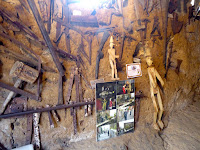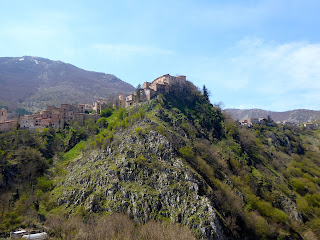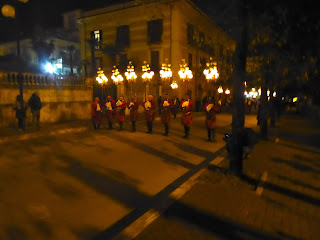Easter Celebrations
April 2019
The crew of Inishnee took another ‘field trip’ to Tuscany, having decided to extend the winter berth contract another 2 months; its still quite chilly in Rome in April. To fill the time, it was decided to see some more of Italy…
 Citiva Di Bagnoregio was a few hours north and east and promised to be a very unusual stop. It was first built and inhabited by the Etruscan’s in the 7th century and has been more or less inhabited since. The current population is 7 (seven!) in the winter and approximately 100 which serves the tourist trade. Its location is remarkable, sitting on a hilltop. An island, connect by a foot bridge. In ancient times there was a land bridge but time, erosion and two world wars pretty much destroyed it. Today, there is a very modern pedestrian bridge costing 5 euros to reach the village. Whether shrouded in clouds, or dusting of snow or gloriously hot and sunny, Civita Di Bagnorgio is a sight to see. Completely walled and sitting isolated atop its rocky perch, a fantasy world conjured from the hands and minds of its original founders. Once inside the city, it only takes an hour to leisurely walk its entirety.
Citiva Di Bagnoregio was a few hours north and east and promised to be a very unusual stop. It was first built and inhabited by the Etruscan’s in the 7th century and has been more or less inhabited since. The current population is 7 (seven!) in the winter and approximately 100 which serves the tourist trade. Its location is remarkable, sitting on a hilltop. An island, connect by a foot bridge. In ancient times there was a land bridge but time, erosion and two world wars pretty much destroyed it. Today, there is a very modern pedestrian bridge costing 5 euros to reach the village. Whether shrouded in clouds, or dusting of snow or gloriously hot and sunny, Civita Di Bagnorgio is a sight to see. Completely walled and sitting isolated atop its rocky perch, a fantasy world conjured from the hands and minds of its original founders. Once inside the city, it only takes an hour to leisurely walk its entirety. 
In another feat of marvelous engineering, the original inhabitants built tunnels and rooms underground… part for safely and part work and living space. We toured one underground space, now a ‘museum’ that was once used for processing olives and storing oil and wine. An olive press cut from stone sits in the middle of the largest space. Cubbies for sleeping and cooking are also etched into the soft(ish) stone.
We had a quick snack in another of these underground spaces, per the recommendation of Rick Steves “Italy’ tour book… And the prices reflected his prior visit… 4 euros each for one slice if bruschetta… but, the location was pretty cool. Sitting next to the old olive press sipping wine, photos posted on the walls showed how a donkey would have worked the press.
From there we made a quick stop in Orvieto hoping to see the underground city there. We had been there 2 other times and missed the tour each visit because it only runs a few times a day in the off season. 3rd time’s the charm, a tour was just starting as we approached and they let us tag along. These ‘caves’ were built for several purpose too. Safety against an invading army, living space for laborers and pigeons… In ancient times pigeons were a dependable and healthy food source. The wealthier land owners lived above ground and each family had their own pigeon ‘coop’ and keeper living below, underground. The pigeons each had a cubbie to come home too. Fresh running water channeled into the cavern type room, and bedding material in their hole. Large windows were cut though the outer walls, south side for heat, in which the pigeons came and went. They foraged on there now and returned nightly to roost. A cheap and easy method, the birds provided eggs and meat to the owners.
 We stayed the night in an Agrotourism lodging. These are very popular in the Tuscany region and provide a small income for the locals. The government regulates these places and requires that the ‘farm, vineyard etc’ make the bulk other income from the land, not from tourism. These lodgings are on the ‘farm’, some in the homes the owner, most in a newer built cabin(s), many offering parking for caravans (RV campers) and tents. We were the only guests this early in the season. Our hosts ran a restaurant on the property which was good since were many kilometers from any village or store. We were told to return for dinner at 8pm which we did. There was no menu but we were assured through gestures there would be food… It was really nice, home cooked food. Several courses with homemade wine. More than we could eat, but we did… the bill? 17 euros for us both…
We stayed the night in an Agrotourism lodging. These are very popular in the Tuscany region and provide a small income for the locals. The government regulates these places and requires that the ‘farm, vineyard etc’ make the bulk other income from the land, not from tourism. These lodgings are on the ‘farm’, some in the homes the owner, most in a newer built cabin(s), many offering parking for caravans (RV campers) and tents. We were the only guests this early in the season. Our hosts ran a restaurant on the property which was good since were many kilometers from any village or store. We were told to return for dinner at 8pm which we did. There was no menu but we were assured through gestures there would be food… It was really nice, home cooked food. Several courses with homemade wine. More than we could eat, but we did… the bill? 17 euros for us both…
Next, we returned to Ostia for a dental appointment (tooth extraction). A couple days of rest and we were back on the road for Easter weekend.
We choose the village of Sulmona as our base. They have a very …different kind of easter celebration; part religious and part pagan, with a whole of tradition.
We stayed on the edge of the old town on a small efficiency apartment… The heat on a timer that left us wanting …
 Sulmona is located in an old and very large prehistoric lake bed, many kilometers wide, circled by snow capped mountains; at least this time of year. The city was nearly destroyed in 1706 from an earthquake but was rebuilt; baroque style architecture. Then bombed during both world wars… it served as a POW camp for both wars as well.
Sulmona is located in an old and very large prehistoric lake bed, many kilometers wide, circled by snow capped mountains; at least this time of year. The city was nearly destroyed in 1706 from an earthquake but was rebuilt; baroque style architecture. Then bombed during both world wars… it served as a POW camp for both wars as well.  Sulmona has a few things of note… Ovid, the roman poet was from here, born March 20, 43 BC. His most famous writing; Metamorphosis; a mythological narrative. His statue stands in the middle of one of the town squares.
Sulmona has a few things of note… Ovid, the roman poet was from here, born March 20, 43 BC. His most famous writing; Metamorphosis; a mythological narrative. His statue stands in the middle of one of the town squares.
And, Confetti! Confetti originated in Sulmona (and northern Italy) in the 1700’s. An old Italian tradition of tossing ‘confetto’, candy coated seeds like coriander, for special events like holidays and weddings. Today, Confetti in Italy is an almond, coated in a candy shell; originally white but many colors and flavors are now available. Over time, other cultures adopted the tradition which, over time, morphed into tossing small pieces of colored paper. Tradition states that certain colors to be used for different occasions: weddings = white, baptisms = pastel pink / blue, graduations = red and anniversaries = silver to gold…


But, we came for the show! Like many religions around the world, easter is very reverent. But, somehow Sulmona has managed to be both solemn and exuberant. Following our arrival on Good Friday, we attended the evenings procession commemorating the crucifixion of Christ. The entire town and thousands of holiday makers turn out for the event. At 8 Pm sharp, the Brotherhood of the Trinita leads and the procession begins. Hundreds (200- 300?) of men (and a couple of women) march through town carrying the likenesses (statues) of Jesus and Mary… They are accompanied by bands (fore and aft) playing a dirge, cross bearing church officials, lantern clad attendants and mourners… This begins continues through the town stopping 13 times at different churches along a path that replicated the shape of the cross. The fallen Christ is then laid to rest at midnight in a church near the main town square. The procession has walked in a slow shuffle, 8-10 across, dozens of rows… with a very practiced march of scuffing their shoes with each step the entire time.

 As they pass, which takes 20 - 30 minutes for the entire group, everyone remains silent and reflective…
As they pass, which takes 20 - 30 minutes for the entire group, everyone remains silent and reflective… 

Castrovolvo can be reached by a very small car. It clings to yet another mountainous peak. Its main income, tourism. We parked in the lot just big enough for 8 or so cars and walked the path to town. It was very sleepy this day, only a few locals enjoying the sun at THE coffee shop. We wandered around, peering over the cliff sides, well, Jim did… Kathy clung to the rock wall of the last building, enjoying the view.
We were curious about the many doors with boards completely blocking the entryways, 2 foot or more high. English not the first language for the villagers, we used google translate to ask about the purpose… This caused a lot of confusion. The phone (translator) was passed around, everyone trying to decipher the message… finally, Jim walked over to one of the doors with the boards and using some universal sign language; pointing and shrugging his shoulders with a questioning look… they understood. Jim was then ushered into the coffee shop and shown a photo… With a LOT of snow in the spot we had just been standing outside… The boards are used to protect the doors and keep snow from getting inside…. The homes with the boards have not been open for the season yet. The owners live in a milder climate for most of the year….

We continued on to Scanno, a mountain village popular with winter skiers. We walked around the old part then lunched at one of the few open restaurants in town… Kathy found a fun new kitchen gadget, a pizzelle maker…
A flat iron that makes thin, wafer cookies with intricate designs. It will take some practice but the first batch turned out pretty good!
Not wanting to drive in the switchback roads after dark, we retired to Sulmona for the evening.
Easter morning… The real reason we came. The DASHing Madonna!
Again, the entire town and thousands of tourist came out for the morning's celebration of the Passion Play…First documented in 1861


 This starts with a procession of the Brotherhood of Santa Maria di Loreto; men with their candelabras, and a few select individuals to carry the statues of the apostles; Saint John and Saint Peter and the now risen Christ. Bands playing cheerful music, the crowd of thousands equally joyful. They march the length of the large square to where Mary has been in seclusion mourning here son… St John (the statue and his 8 man team) attempts to coax her out but she doesn't believe his story that Christ is alive… Nor does she believe St Peter…
This starts with a procession of the Brotherhood of Santa Maria di Loreto; men with their candelabras, and a few select individuals to carry the statues of the apostles; Saint John and Saint Peter and the now risen Christ. Bands playing cheerful music, the crowd of thousands equally joyful. They march the length of the large square to where Mary has been in seclusion mourning here son… St John (the statue and his 8 man team) attempts to coax her out but she doesn't believe his story that Christ is alive… Nor does she believe St Peter… But, eventually she relents and enters the square with her team of 8 robust men… Still clad in her back mourning cape she slowly makes her way toward the opposite end of the square… when, suddenly she she's Him! At noon, there’s a great explosion of a cannon, doves burst from around her and take flight. Her black cape miraculously flies from her shoulders to reveal her spring green easter dress and she dashes ( to the other end of the square where she is reunited with her son!!!!!! It’s all over in a flash. I’m pretty sure is was a fantastic event. Unfortunately the many dozen heads, arms and cameras in front of us blocked nearly everything… but, thanks to You Tube we got to see it at home…
Lore has it that if her cloak doesn't fall / land properly the town will have bad luck (calamities and natural disasters) … if she is dropped! it’s a very bad omen… The only two times she ‘fell’ were in 1914 and again in 1940… according to some; a prediction of war!







































No comments:
Post a Comment